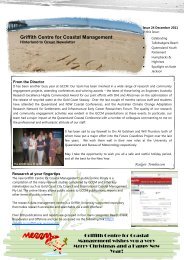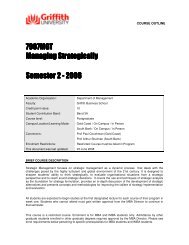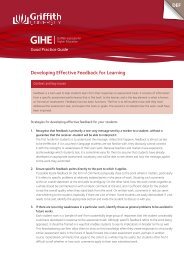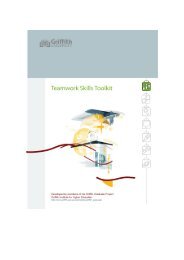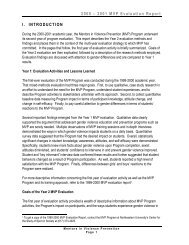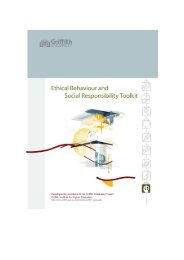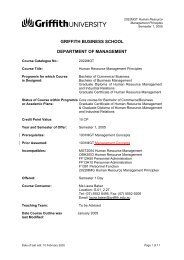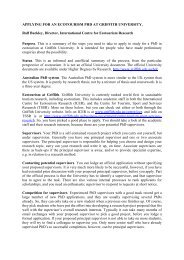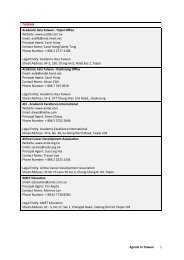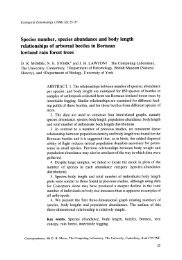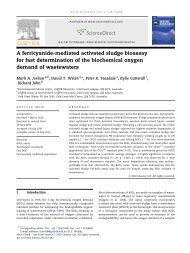Health Check Issue 19 2008 (PDF 283k) - Griffith University
Health Check Issue 19 2008 (PDF 283k) - Griffith University
Health Check Issue 19 2008 (PDF 283k) - Griffith University
You also want an ePaper? Increase the reach of your titles
YUMPU automatically turns print PDFs into web optimized ePapers that Google loves.
3<br />
www.griffith.edu.au/health 5<br />
Head of School<br />
measures up<br />
Professor Peter Milburn started his<br />
career as a physical education teacher<br />
and still loves the process of teaching<br />
and learning, understanding how people<br />
learn new skills, enabling people to<br />
participate safely, and finding creative<br />
ways to meet those needs.<br />
His new role as head of the School of<br />
Physiotherapy and Exercise Science<br />
gives him the opportunity to further<br />
pursue that passion and extend the<br />
School’s reputation as a provider<br />
of high-quality undergraduate and<br />
postgraduate programs.<br />
Professor Milburn said the strength<br />
in <strong>Griffith</strong>’s exercise science program<br />
underpinned the School’s overall success.<br />
“Exercise science is an entirely<br />
appropriate starting point for careers in<br />
physiotherapy and <strong>Griffith</strong> is recognised<br />
for its unique double-degree program<br />
that builds on the synergies between<br />
the two disciplines.”<br />
“I see the opportunities here are<br />
to further define alternate career<br />
pathways for exercise scientists and<br />
enhance their employability in areas<br />
such as sport, health and education,”<br />
he said.<br />
Professor Milburn helped establish<br />
human movement studies at the<br />
<strong>University</strong> of Wollongong and also<br />
supervised the transition of the<br />
Bachelor of Physiotherapy program<br />
from New Zealand’s Otago Polytechnic<br />
to the <strong>University</strong> of Otago.<br />
As well teaching at <strong>Griffith</strong>, he said he<br />
looks forward to playing a mentoring<br />
role for the many new and early career<br />
researchers in the School.<br />
His own areas of research are<br />
based on biomechanical analyses of<br />
musculoskeletal stress during activities<br />
such as sport and at work.<br />
”I’m particularly interested in the<br />
development and application<br />
Professor Peter Milburn<br />
of new technologies such as<br />
stereophotogrammetry which allows<br />
us to take accurate three dimensional<br />
measurements of the shape of the back<br />
and spine.”<br />
Some of his current projects include<br />
documenting the change in shape of<br />
the spine as it compresses and bends<br />
during the course of the day, during<br />
high intensity activity such as rugby<br />
scrums or pace bowling, and in specific<br />
conditions such as pregnancy.<br />
He is also interested in developing<br />
targeted exercise programs for<br />
overweight children who already suffer<br />
from extra loading on their knee and hip<br />
joints and typically experience pain or<br />
discomfort with physical activity.<br />
International<br />
researchers flexing their<br />
collective muscle<br />
A Memorandum of Understanding<br />
(MoU) to develop collaborative research<br />
initiatives in exercise physiology and<br />
other areas has been signed by the<br />
<strong>University</strong> of Copenhagen Muscle<br />
Research Centre and <strong>Griffith</strong> <strong>Health</strong>.<br />
The MoU initially supports a research<br />
partnership between <strong>Griffith</strong>’s muscle<br />
physiologist Dr Luke Haseler and<br />
internationally recognised exercise<br />
physiologist Professor Bengt Saltin,<br />
founder of the Copenhagen Muscle<br />
Research Centre.<br />
The two researchers have teamed up<br />
to further investigate how muscles use<br />
oxygen. Their findings will contribute<br />
valuable information to help combat<br />
heart and lung diseases such as chronic<br />
heart failure and chronic obstructive<br />
pulmonary disease.<br />
Professor Saltin’s extensive experience<br />
in the field and Dr Haseler’s expertise in<br />
magnetic resonance spectroscopy make<br />
for an extremely effective partnership.<br />
While magnetic resonance imaging<br />
(MRI) scanners are best known for<br />
taking images of the brain, Dr Haseler<br />
has designed a system for scanning<br />
lower limbs and obtaining real-time<br />
information on muscle function including<br />
the matching of oxygen delivery to<br />
metabolic demand.<br />
“Only a handful of places in the world<br />
can do these metabolic measurements,”<br />
he said.<br />
“Hopefully we will be able to tease<br />
out whether the problem in people<br />
with these conditions is due to poor<br />
blood flow and oxygen delivery to the<br />
muscle or a problem within the muscles<br />
themselves.”<br />
The research will also provide evidence<br />
about the effectiveness of exercise<br />
training in managing these conditions.<br />
The MoU builds on a 2006 Exchange<br />
Agreement for student and staff<br />
exchange between the two institutions,<br />
and mutual strengths in medicine, oral<br />
health, public health and biomedical<br />
sciences.




